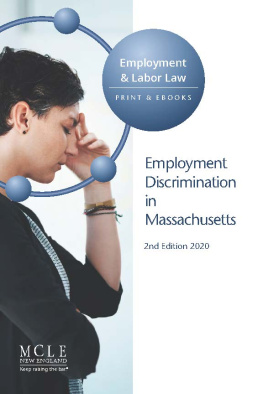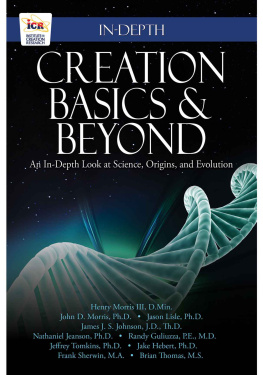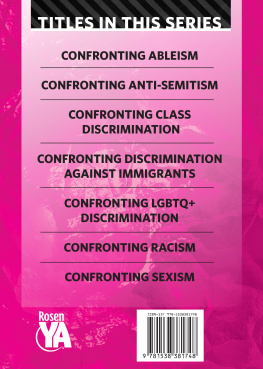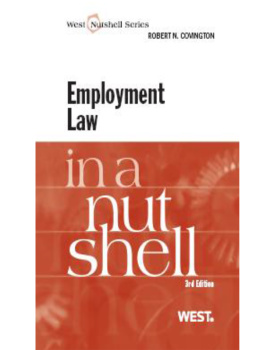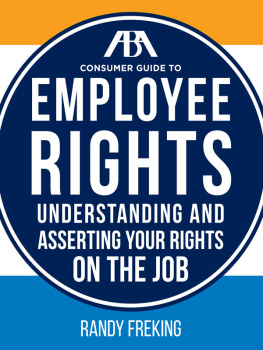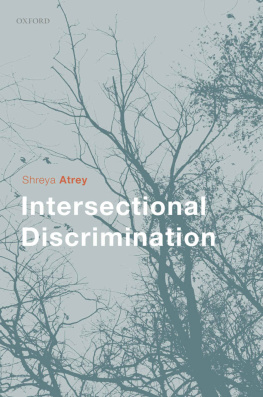Various - Employment Discrimination in Massachusetts
Here you can read online Various - Employment Discrimination in Massachusetts full text of the book (entire story) in english for free. Download pdf and epub, get meaning, cover and reviews about this ebook. City: Boston, year: 2020, publisher: Massachusetts Continuing Legal Education, Inc. (MCLE), genre: Politics. Description of the work, (preface) as well as reviews are available. Best literature library LitArk.com created for fans of good reading and offers a wide selection of genres:
Romance novel
Science fiction
Adventure
Detective
Science
History
Home and family
Prose
Art
Politics
Computer
Non-fiction
Religion
Business
Children
Humor
Choose a favorite category and find really read worthwhile books. Enjoy immersion in the world of imagination, feel the emotions of the characters or learn something new for yourself, make an fascinating discovery.
Employment Discrimination in Massachusetts: summary, description and annotation
We offer to read an annotation, description, summary or preface (depends on what the author of the book "Employment Discrimination in Massachusetts" wrote himself). If you haven't found the necessary information about the book — write in the comments, we will try to find it.
Various: author's other books
Who wrote Employment Discrimination in Massachusetts? Find out the surname, the name of the author of the book and a list of all author's works by series.
Employment Discrimination in Massachusetts — read online for free the complete book (whole text) full work
Below is the text of the book, divided by pages. System saving the place of the last page read, allows you to conveniently read the book "Employment Discrimination in Massachusetts" online for free, without having to search again every time where you left off. Put a bookmark, and you can go to the page where you finished reading at any time.
Font size:
Interval:
Bookmark:
Scope Note
This chapter provides a basic introduction to employmentdiscrimination law, covering both theories of liability: disparate treatmentand disparate impact. It lays out the elements of a case, the parties'respective burdens of proof, and relevant case law.
An employee who has beendiscriminated against on the basis of their race, gender, age, or membership inanother protected category rarely has "direct" evidence of discriminationbecause an employer is unlikely to tell an employee that it is making anadverse decision about the employee because of the employee's legally protectedcharacteristic. Instead, the vast majority of discrimination cases involve"indirect" or circumstantial evidence of disparate treatment. Circumstantialevidence is no less powerful than direct evidence, however. See DesertPlace, Inc. v. Costa, 539 U.S. 90, 100 (2003) ("Circumstantial evidence isnot only sufficient, but may also be more certain, satisfying and persuasivethan direct evidence.") (citing Rogers v. Mo. Pac. R.R. Co., 352 U.S.500, 508, n.17 (1957)). For example, a highly qualified woman may claim thatshe was denied a promotion because of her gender when the employer promoted aless qualified man instead. The plaintiff would present circumstantial evidenceof discriminatory treatment and the fact finder may draw inferences from theevidence to determine that the employer's decision violated G.L. c. 151B or theapplicable federal statute. Both federal and state courts have adoptedframeworks for considering claims of disparate treatment where there is nodirect evidence of the employer's discriminatory intent.
This overview ofMassachusetts discrimination law focuses on both disparate treat ment anddisparate impact cases. The overview sets forth "black letter" law on the elements of and the parties' respective burdens ina disparate treatment case and pre sents a summary of the burdens indisparate impact discrimination cases.
Where an employee relies on indirect evidence ofdiscrimination, the employee "must demonstrate four things: that he or she is amember of a protected class; that he or she was subject to an adverseemployment action; that the employer bore 'discriminatory animus' in takingthat action; and that animus was the reason for the action (causation)." Bulwerv. Mt. Auburn Hosp., 473 Mass. 672, 680 (2016) (citing Lipchitz v.Raytheon Co., 434 Mass. 493, 502 (2001)). Where there is no direct evidence,an employee may instead provide indirect or circumstantial evidence of discrimination.One method of doing so is by "using the familiar three-stage, burden-shiftingparadigm first set out in McDonnell Douglas Corp. v. Green, 411 U.S.792, 802805 (1973)." Bulwer v. Mt. Auburn Hosp., 473 Mass. at 680.
In the first stage, the plaintiff must produce "evidence ofa prima facie case of discrimination," showing that
they are a member of a class protected by G.L. c. 151B;
they performed their job at an acceptable level;
they were treated differently than another person not in their protectedclass but otherwise similarly situated; and
they suffered an adverse action.
Yee v. Mass. State Police,481 Mass. 290, 29495 (2019) (citing Trs. of Health & Hosps. of Bos.,Inc. v. MCAD, 449 Mass. 675, 68182 (2007); Verdrager v. Mintz, Levin,Cohn, Ferris, Glovsky & Popeo, P.C., 474 Mass. 382, 396 (2016). SeeYee v. Mass. State Police, 481 Mass. at 295 n.5 ("The elements of the primafacie case may vary depending on the nature of the discrimination claim.")."[T]he plaintiff's initial burden of establishing a prima facie case is notintended to be onerous." Sullivan v. Liberty Mut. Ins., 444 Mass. 34, 45(2005). Rather, "[i]t is meant to be a small showing that is easily made." Sullivanv. Liberty Mut. Ins., 444 Mass. at 45. If the plaintiff meets the burden ofestablishing a prima facie case, "unlawful discrimination is presumed" and theburden of production shifts to the employer. Matthews v. Ocean SprayCranberries, Inc., 426 Mass. 122, 128 (1997).
In the second stage, the employer must articulate a"legitimate, nondiscriminatory reason for its employment decision." Yee v.Mass. State Police, 481 Mass. at 302 (citing Verdrager v. Mintz, Levin,Cohn, Ferris, Glovsky & Popeo, P.C., 474 Mass. at 397 (additionalcitation omitted)). The employer's obligation is "to produce both 'lawful...reasons for [its] employment decision' and 'credible evidence to show that the... reasons advanced were the real reasons.'" Bulwer v. Mt. Auburn Hosp.,473 Mass. at 683 (quoting Blare v.Husky Injection Molding Sys. Bos.,Inc., 419 Mass. 437, 442 (1995)). Such reasons must have been known to theemployer at the time it took the adverse action. City of Boston v. MCAD,39 Mass. App. 234, 241 (1995) ("[t]he basis for discharge must be one which isknown to the employer at the time of termination" where employer sought to relyon an allegedly falsified application). Like the plaintiff's burden in theprima facie stage, the employer's burden is "not meant to be onerous." Yeev. Mass. State Police, 481 Mass. at 302 (citing Blare v. Husky InjectionMolding Sys. Bos., Inc., 419 Mass. at 442). "Even if the reasons given arearguably suspect, so long as the [employer] has produced a lawful reason backedby some credible evidence, it has satisfied this burden." Yee v. Mass. StatePolice, 481 Mass. at 302 (citing Matthews v. Ocean Spray Cranberries,Inc., 426 Mass. at 128). Nevertheless, in order to meet its burden, theemployer's "explanation must not be wholly unbelievable such that an underlyingdiscriminatory motive is obvious." Yee v. Mass. State Police, 481 Mass.at 302 (citing Wheelock Coll. v. MCAD, 371 Mass. 130, 138 (1976)). It isimportant to note that an employer's contention that an employee was notperforming at an acceptable level must only be viewed at the "pretext" andfinal stage of the McDonnell Douglas burden-shifting framework andcannot be used as a means to challenging the employee's prima facie case. Fontainev. Ebtec Corp., 415 Mass. 309, 312 n.6 (1993); Williams v. Frank,757 F. Supp. 112, 117 (D. Mass. 1991) (the incident involving alleged poorperformance "is more logically viewed as a defense to be raised by the employerat the second stage of the McDonnell Douglas framework rather than animpediment to the plaintiff's prima facie case").
At the third stage, the burdenshifts back to the employee to produce evidence that "the employer'sarticulated justification [for the adverse action] is not true but a pretext." Bulwerv. Mt. Auburn Hosp., 473 Mass. at 681 (quoting Blare v. Husky InjectionMolding Sys. Bos., Inc., 419 Mass. at 443) (alteration in original)). Sincedirect, "smoking gun" evidence is rare, the employee may carry their burden ofpersuasion with circumstantial evidence that persuades the fact finder that theemployer's explanation is not credible. City of Salem v. MCAD, 44 Mass.App. Ct. 627, 642 (1998). The employee's proof of pretext may include showing"weaknesses, implausibilities, inconsistencies, incoherencies, orcontradictions in the employer's proffered legitimate reasons for its action." Cityof Salem v. MCAD, 44 Mass. App. Ct. at 643 (citations omitted); see alsoLoeb v. Textron, Inc., 600 F.2d 1003 (1st Cir. 1979) ("The reasonablenessof the employer's reasons may of course be probative of whether they arepretexts. The more idiosyncratic or questionable the employer's reason, theeasier it will be to expose it as a pretext, if indeed it is one.").
Font size:
Interval:
Bookmark:
Similar books «Employment Discrimination in Massachusetts»
Look at similar books to Employment Discrimination in Massachusetts. We have selected literature similar in name and meaning in the hope of providing readers with more options to find new, interesting, not yet read works.
Discussion, reviews of the book Employment Discrimination in Massachusetts and just readers' own opinions. Leave your comments, write what you think about the work, its meaning or the main characters. Specify what exactly you liked and what you didn't like, and why you think so.

